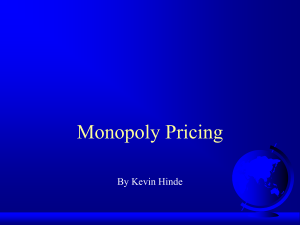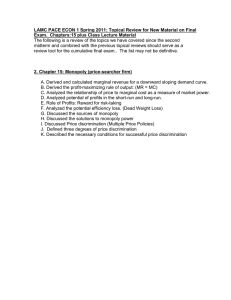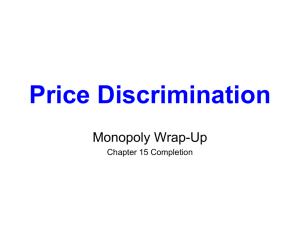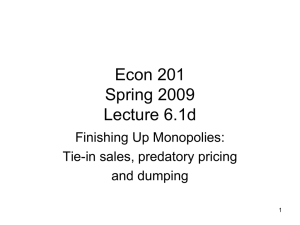Econ 201 Lecture 5.4 Summer 2009 Market Failure:
advertisement
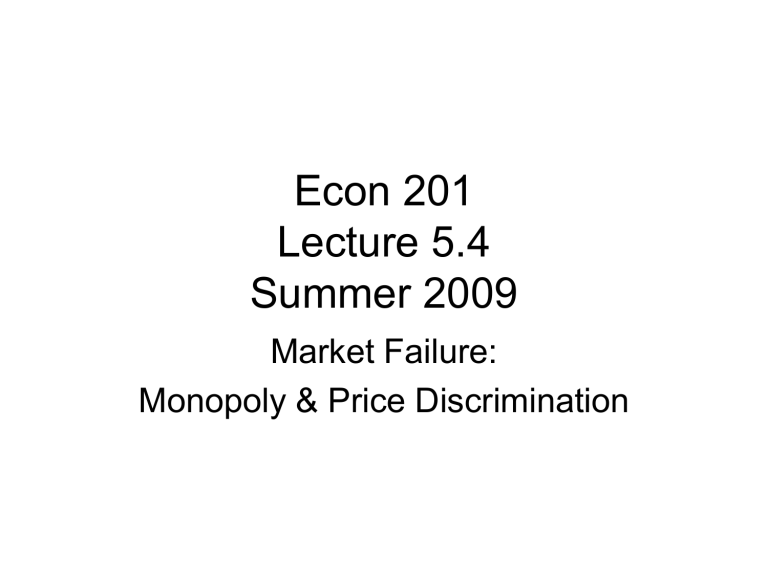
Econ 201 Lecture 5.4 Summer 2009 Market Failure: Monopoly & Price Discrimination More Complex Monopoly Pricing Schemes • Classic categorization of monopolies – 3 levels of price discrimination • First degree (Perfect Price Discrimination) – Extract almost all of the Consumer Surplus » Able to get a different price for each unit sold » Moves consumer along the Demand Curve • Second degree – Provide quantity discounts; but have to buy in blocks, with each larger block having a lower price than the last • Third degree – Different prices for same good in different markets • In all cases, it is necessary to prevent resale and new entrants Price Discrimination • Because they have market power, monopolists could practice price discrimination. – Price discrimination is the practice of separating customers into groups based on willingness to pay, then charging each group a different price. First-Degree Price Discrimination • Under first-degree price discrimination, each customer is charged the highest price they are willing and able to pay. – Example: Dutch auction – The monopolist can capture the entire consumer surplus. Second-Degree Price Discrimination • Second-degree price discrimination occurs when firms sell their product at a discount when consumers buy large quantities. – Example: Electricity prices? • http://www.amosweb.com/cgibin/awb_nav.pl?s=wpd&c=dsp&k=seco nd-degree+price+discrimination Third-Degree Price Discrimination • Under third-degree price discrimination, a firm charges different prices in different markets for their product. – The most common form of price discrimination – Examples include: • Children's discounts • Senior citizen’s discounts • Airfares Third Degree Price Discrimination • Choose Qs based – MR = MC for market demand • Set price for each segment – Equating MC(market) to MR for each segment – Setting price for Qs (segment) • Zone pricing – Gas stations? – Grocery stores? – Senior citizen discounts? Third Degree Price Discrimination • Setting separate prices in each market • http://www.nowsell.com/marketing-guide/price-discrimination.html Other Monopolist Pricing Strategies • • • • • • • Perfect Price Discrimination: 1st degree Block Pricing: 2nd degree Zone Pricing: 3rd degree Tie-in Sales Predatory Pricing Dumping All aimed at extracting Consumer Surplus To Be Able to Do Price Discrimination • To be a successful price discriminator, a seller must satisfy three conditions: – (1) to have market control and be a price maker, – (2) to identify two or more groups that are willing to pay different prices, and – (3) to keep the buyers in one group from reselling the good to another group. A Word from the FTC on Discriminatory Pricing • A seller charging competing buyers different prices for the same "commodity" or discriminating in the provision of "allowances" -- compensation for advertising and other services -- may be violating the Robinson-Patman Act. This kind of price discrimination may hurt competition by giving favored customers an edge in the market that has nothing to do with the superior efficiency of those customers. However, price discriminations generally are lawful, particularly if they reflect the different costs of dealing with different buyers or result from a seller’s attempts to meet a competitor’s prices or services. Tie-In Sales • A tie-in sale: – consumer can only obtain the desired good (tying good) if he agrees also to purchase a different good (tied good) from the producer. – What it accomplishes: – (1) the tie-in can be a substitute for a lump sum payment tailored to extract the consumer’s surplus in the tying good market; – (2) the tie-in serves to price discriminate among types of consumers having different demand elasticities; Optimal Pricing Strategy for a Tie-in Sale • Lower the price in the more demand elastic market • Raise price above MC in the more inelastic market IBM Example • So optimal pricing strategy – Underprice computers in order to sell at a single price to both high and low demand customers – Price cards at > MC in order to extract CS • Boeing – Airplane market was more competitive – WTP correlated with miles – Tied-in on-board navigational systems Other Examples • Automobile warranties – Cars bought/sold in a competitive marketplace – Warranty maintenance must be performed at dealer’s or authorized shop (costs > MC?) • Soda (other goods) at Gas stations – Gas bought/sold in a more competitive market – Soda prices > MC Predatory Pricing • Predatory pricing – firm sells a product at very low price attempting to drive competitors out of the market, • or create a barrier to entry for potential new competitors. • If the other firms cannot sustain equal or lower prices without losing money, they go out of business. – The predatory pricer then has fewer competitors or even a monopoly, allowing it to raise prices above what the market would otherwise bear. Predatory Pricing • In many countries, including the United States, predatory pricing is considered anti-competitive and is illegal under antitrust laws. • Usually difficult to prove that a drop in prices is due to predatory pricing rather than normal competition • Predatory pricing claims are difficult to prove due to high legal hurdles designed to protect legitimate price competition. The Standard Oil Case • • Rockefeller’s Standard Oil Monopoly (1911) The efficiencies of economies of scale and vertical integration caused the prices of refined petroleum to fall from over 30 cents a gallon in 1869 to 10 cents by 1874 and to 5.9 cents by 1897. During the same period, Rockefeller reduced his average costs from 3 cents to 0.29 cents per gallon. • Contrary to popular mythology, Standard Oil’s market share declined from 88 percent in 1890 to 64 percent by 1911. Because of intense competition the company's oil production as a percentage of total market supply had declined to a mere 11 percent in 1911, down from 3 percent in 1898. • McGee shows that rather than practicing predatory pricing. Std Oil was able to build its monopoly through the purchase of other refineries. McGee, John S. "Predatory Price Cutting: The Standard Oil (N.J.) Case."J. Law and Econ. 1 (October 1958): 137-69. • Another Explanation • McGee, John, "Predatory Price Cutting: The Standard Oil (N.J.) Case," Journal of Law and Economics Vol 1 (April 1958) • Buy out other gas stations at a price higher than the competitive value, based on possible future monopolistic value Dumping • "dumping" can refer to any kind of predatory pricing. • Term is now generally used only in the context of international trade law, where dumping is defined as the act of a manufacturer in one country exporting a product to another country at a price which is either below the price it charges in its home market or is below its costs of production. • The term has a negative connotation, but advocates of free markets see "dumping" as beneficial for consumers and believe that protectionism to prevent it would have net negative consequences. • Advocates for workers and laborers however, believe that safeguarding businesses against predatory practices, such as dumping, help alleviate some of the harsher consequences of free trade between economies at different stages of development What’s the Downside to Monopolies? • Economically inefficient – Deadweight loss • Higher price and lower quantity demanded/supplied – Transfer losses • From CS to PS • Economists have no opinion – Pareto efficient – No/less incentive for innovation Factors Working Against Persistence • Monopoly rents attract entry of other firms – First mover advantage • monopolies tend to become less efficient and innovative over time, – complacent giants", do not have to be efficient or innovative to compete in the marketplace • One of the arguments advanced by AT&T for deregulating the Telecomm industry in 1996 • Availability in the longer term of substitutes in other markets. For example, a canal monopoly, while worth a great deal in the late eighteenth century United Kingdom, was worth much less in the late nineteenth century because of the introduction of railways as a substitute. • However, loss of efficiency can raise a potential competitor's value enough to overcome market entry barriers, or provide incentive for research and investment into new alternatives. Does a Single Supplier Always Mean There is a Monopoly? • The theory of contestable markets argues that in some circumstances (private) monopolies are forced to behave as if there were competition because of the risk of losing their monopoly to new entrants. • This is likely to happen where a market's barriers to entry are low. • Single supplier does not necessarily mean there is a monopoly – Firm may behave as though its in a competitive market Natural Monopolies Natural Monopolies (monopolies of scale) – When monopolies are not broken through the open market, often a government will step in, • regulate the monopoly, turn it into a publicly owned monopoly, • forcibly break it up (see Antitrust law). Public utilities, • Natural monopolies are less susceptible to efficient breakup, – strongly regulated or publicly owned. – AT&T and Standard Oil are debatable examples of the breakup of a private monopoly. When AT&T was broken up into the "Baby Bell" components, MCI, Sprint, and other companies were able to compete effectively in the long distance phone market and began to take phone traffic from the less efficient AT&T.
